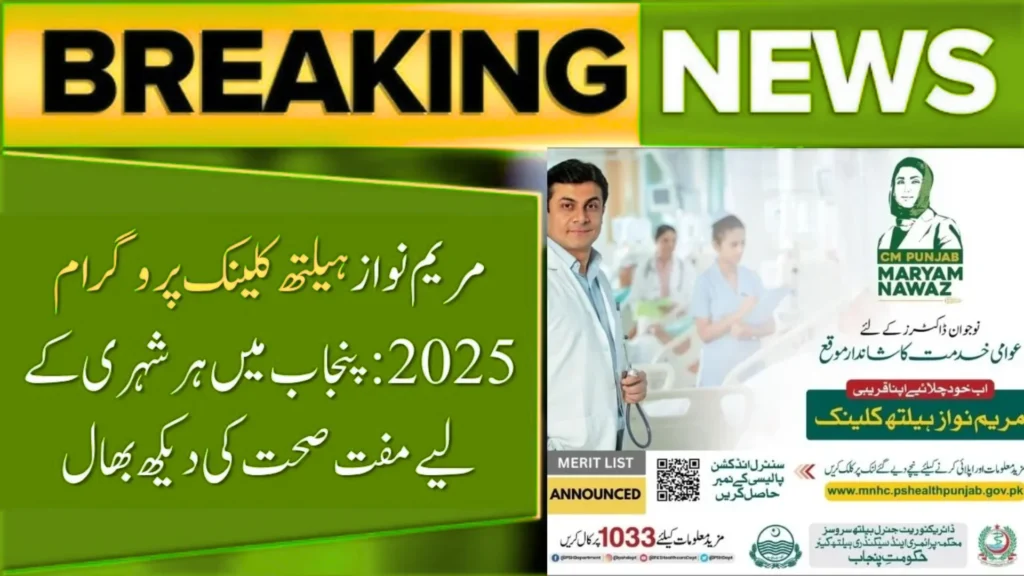
The Maryam Nawaz Sharif Health Clinic Program is a flagship healthcare initiative launched in Punjab in January 2025. According to the provincial government’s official website, the project transforms selected Basic Health Units (BHUs) and rural clinics into modern “Maryam Nawaz Health Clinics” (MNHCs) that offer improved healthcare access, upgraded infrastructure and digital patient-care systems. The program was inaugurated with the conversion of 150 health centres in the initial phase.
Why It Matters
From my experience working with local health-care NGOs in Punjab, I can say that access to quality primary health services has long been inconsistent, especially in rural and under-served areas. With this new program:
- Residents in remote tehsils will get clinics with upgraded equipment and services.
- Digital systems aim to reduce delays and paper-based inefficiencies.
- Bringing young doctors and private-management models may raise quality and responsiveness.
The government expects that by outsourcing high-performing units and upscaling care, the burden on district hospitals will ease and patients will receive more timely care.
Features & Services
Here are the main features of the program:
- Outsourced management: 150 BHUs converted into MNHCs under the new model and further scaling planned to nearly 1,000 units.
- Digital patient-care: The full clinic workflow from registration to treatment is digitised.
- Infrastructure upgrade: Clinics get new furniture, washrooms, clean interiors and equipment like ECG, CT/MRI where applicable.
- Expanded services: Outpatient care, maternal and child health, family planning, diagnostics, free medicines in many cases.
- Accessibility: The aim is to cover all 36 districts of Punjab, including remote and tribal regions.
Comparative Table – Initial Phase
| Metric | Phase I (Initial) | Phase II / Expansion |
|---|---|---|
| Number of clinics/BHUs | ~150 | Planned expansion to ~971 or more |
| Digital patient-care system | Starting roll-out | Full digitisation planned |
| Infrastructure upgrade | Select BHUs | Broader roll-out across districts |
| Services offered | Basic outpatient care, maternal & child health | More diagnostic services + free medicines |
Implementation & Roll-Out
This program is being implemented in stages. In January 2025 the first 150 Health Clinics were launched. The government has indicated that up to 971 BHUs will be converted into MNHCs under the next phase. Staff adjustments and outsourcing arrangements have already been initiated with over 1,000 healthcare officers transferred from outsourced BHUs as part of the model.
In practical rollout:
- The district health authorities identify BHUs for conversion.
- Doctors and young healthcare professionals are given contracts for the new clinics.
- Digital infrastructure and management systems are set up.
- The clinics begin operations with upgraded facilities and improved services.
Impact So Far
Early data and official statements show promising results:
- Clinics look cleaner, the furniture has been replaced, and patients report shorter wait times.
- The program is integrated with other initiatives such as field-hospitals and outreach “Clinic-on-Wheels” units.
- The government reports distribution of free medicines worth billions of rupees in OPDs across Punjab under its broader health reforms.
Challenges to Watch
Despite the strong foundations, a few challenges remain:
- Ensuring consistent quality across all converted BHUs will require strong oversight given the scale of expansion.
- Remote-area infrastructure (roads, power, internet) may still lag behind leading clinics, affecting digital systems.
- Long-term sustainability: Outsourcing and contract models need fiscal discipline and performance monitoring to avoid cost overruns.
- Public awareness: Patients need to trust the upgraded clinics, understand new services and digital workflows.
What It Means for You
If you live in Punjab and use public health services:
- Check whether your local BHU has been converted into a Maryam Nawaz Health Clinic and what new services are available.
- Carry your ID and any previous medical records so you can benefit from upgraded diagnostics or free medicines.
- Give feedback: Many of these clinics have help-desks or digital complaint systems, your input helps improve service.
- Expect the clinic experience to change: cleaner premises, digital registration, possibly new doctors and extended hours.
Future Outlook
• The expansion to nearly 1,000 centres means the program will soon cover very remote areas that have long lacked quality primary care.
• Integration with larger hospitals and diagnostics means the MNHCs can act as effective referral hubs rather than just basic units.
• As digital medical records and monitoring grow, data-driven healthcare decisions in Punjab may increase, improving public-health outcomes.
• Over time, the model may reduce the load on tertiary hospitals and improve overall efficiency of the health system in Punjab.
Conclusion
The Maryam Nawaz Health Clinic Program is a serious attempt to modernise primary healthcare across Punjab. It’s not just about re-branding clinics, it’s about upgrading infrastructure, bringing in new management models, digitising care and expanding access to underserved citizens. If rollout continues at pace and quality is maintained, this initiative has real potential to change how public healthcare works in Punjab. Keep an eye on your local clinic, you may see tangible improvements.
FAQs
- What is the Maryam Nawaz Health Clinic Program?
It is a healthcare reform initiative in Punjab launched in January 2025 to convert selected BHUs into modern clinics with digital and upgraded services. - How many clinics are being converted in the first phase?
The first phase involves around 150 health centres being transformed into MNHCs. - What services will these clinics offer?
Outpatient care, maternal and child health, diagnostics, upgraded infrastructure, digital records and free medicines in many cases. - Are all districts in Punjab covered?
The goal is to cover all 36 districts; the expansion phase aims to make this comprehensive. - Does this program involve outsourcing or private management?
Yes, many clinics are outsourced and managed under contracts to improve efficiency and accountability. - How can patients benefit from the upgrades?
Patients can expect improved facility conditions, shorter wait times, better diagnostics and digital registration processes. - What types of infrastructure upgrades are included?
New furniture, clean interiors, digital systems, diagnostic tools (ECG, CT/MRI in some cases) and better amenities. - Will the services be free?
Core services are provided at public cost; many clinics offer free medicines and diagnostics under the broader health reform programme. - How can doctors apply for these clinics?
Medical professionals can apply via the official portal, subject to qualifications, registration and district preferences. - What is the expected long-term impact?
The long-term impact includes stronger primary healthcare, reduced load on hospitals, improved access in rural areas, and better health outcomes across Punjab.




